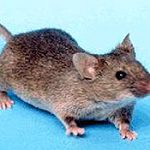The House Mouse (Mus musculus) is one of the most numerous species of the genus Mus commonly termed a mouse. It is a small mammal and a rodent.
Laboratory mice belong to strains of House Mice and are some of the most important model organisms in biology and medicine; they are by far the most commonly used genetically altered laboratory mammal.
House mice have an adult body length (nose to base of tail) of 7.5-10 cm (3.0-3.9 in) and a tail length of 5-10 cm (2.0-3.9 in); the weight is typically 10-25 g (0.35-0.88 oz). They vary from white to grey, light brown to black, with short hair and a light belly. The ears and tail have little hair. The hind feet are short compared to Apodemus mice, only 15-19 mm (0.59-0.75 in) long; the normal gait is a run with a stride of about 4.5 cm (1.8 in), though they can jump up to 45 cm (18 in). The droppings are blackish, about 3 mm (0.12 in) long, and have a strong musty smell. The voice is a high-pitched squeak.

